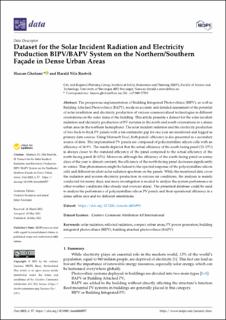| dc.contributor.author | Gholami, Hassan | |
| dc.contributor.author | Røstvik, Harald Nils | |
| dc.date.accessioned | 2021-06-01T09:18:23Z | |
| dc.date.available | 2021-06-01T09:18:23Z | |
| dc.date.created | 2021-05-27T12:51:55Z | |
| dc.date.issued | 2021-05 | |
| dc.identifier.citation | Gholami, H., Røstvik, H.N. (2021) Dataset for the Solar Incident Radiation and Electricity Production BIPV/BAPV System on the Northern/Southern Façade in Dense Urban Areas. Data, 6 (6), 57 | en_US |
| dc.identifier.issn | 2306-5729 | |
| dc.identifier.uri | https://hdl.handle.net/11250/2757174 | |
| dc.description.abstract | The prosperous implementation of Building Integrated Photovoltaics (BIPV), as well as Building Attached Photovoltaics (BAPV), needs an accurate and detailed assessment of the potential of solar irradiation and electricity production of various commercialised technologies in different orientations on the outer skins of the building. This article presents a dataset for the solar incident radiation and electricity production of PV systems in the north and south orientations in a dense urban area (in the northern hemisphere). The solar incident radiation and the electricity production of two back-to-back PV panels with a ten-centimetre gap for one year are monitored and logged as primary data sources. Using Microsoft Excel, both panels’ efficiency is also presented as a secondary source of data. The implemented PV panels are composed of polycrystalline silicon cells with an efficiency of 16.9%. The results depicted that the actual efficiency of the south-facing panel (13–15%) is always closer to the standard efficiency of the panel compared to the actual efficiency of the north-facing panel (8–12%). Moreover, although the efficiency of the south-facing panel on sunny days of the year is almost constant, the efficiency of the north-facing panel decreases significantly in winter. This phenomenon might be linked to the spectral response of the polycrystalline silicon cells and different incident solar radiation spectrum on the panels. While the monitored data cover the radiation and system electricity production in various air conditions, the analysis is mainly conducted for sunny days, and more investigation is needed to analyse the system performance in other weather conditions (like cloudy and overcast skies). The presented database could be used to analyse the performance of polycrystalline silicon PV panels and their operational efficiency in a dense urban area and for different orientations. | en_US |
| dc.language.iso | eng | en_US |
| dc.publisher | MDPI | en_US |
| dc.relation.uri | https://doi.org/10.3390/data6060057 | |
| dc.rights | Navngivelse 4.0 Internasjonal | * |
| dc.rights.uri | http://creativecommons.org/licenses/by/4.0/deed.no | * |
| dc.subject | datasett | en_US |
| dc.subject | solstråling | en_US |
| dc.subject | energi | en_US |
| dc.title | Dataset for the Solar Incident Radiation and Electricity Production BIPV/BAPV System on the Northern/Southern Façade in Dense Urban Areas | en_US |
| dc.type | Peer reviewed | en_US |
| dc.type | Journal article | en_US |
| dc.description.version | publishedVersion | en_US |
| dc.rights.holder | © 2021 by the authors | en_US |
| dc.subject.nsi | VDP::Teknologi: 500 | en_US |
| dc.source.pagenumber | 15 | en_US |
| dc.source.volume | 6 | en_US |
| dc.source.journal | Data | en_US |
| dc.source.issue | 6 | en_US |
| dc.identifier.doi | 10.3390/data6060057 | |
| dc.identifier.cristin | 1912233 | |
| dc.source.articlenumber | 57 | en_US |
| cristin.ispublished | true | |
| cristin.fulltext | original | |
| cristin.qualitycode | 1 | |

